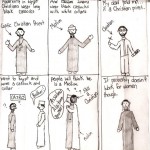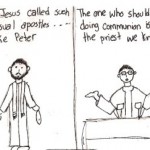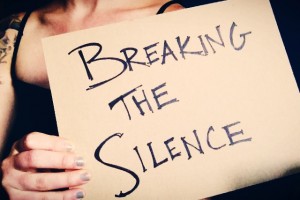
Our Stories Untold.
Rachel Halder is holding the sign.
This is part I of our series, Clerical Sexual Boundary Violations.
To CSBV II: Anatomy of a Sexual Misconduct Cover-Up: How (and Why) Did Church Leaders Negotiate with the New York Post to Misreport Potentially Embarassing Information?
To CSBV III: Presbyterian Pastor Doubles as Escort: A youth minister engages a woman in a sexual relationship, and then entrusts her with his secrets.
An Interview with
Rachel Halder
Editor of Our Stories Untold
I actually came across the work of Rachel Halder while trying to find my own blog, Stories Untold, on Google. Her website, Our Stories Untold, came up in the search results. At first a bit embarrassed that I had a blog with the same name as someone else’s site, I got over it and realized that Halder is doing an incredible piece of documentary journalism.
Since June 2012, Halder has published, online, five previously untold stories of sexualized violence within Mennonite communities. She has compiled some 20 more, which the survivors do not feel comfortable putting on the Internet. All the online stories are from women, but, Halder says, she has also received stories from men. Among the men, they are all stories of child abuse; among the women, more than half are about abuse when they were teenagers. And in many cases, Mennonite institutions — schools, churches — suppressed public information about the violence.
I believe there was pressure on the school to cover the [rape] up because they didn’t want Mennonite congregations to think that something like this could happen at our nice, little, safe Christian campus community. [from Story 3: Legitimate Rape]
Mennonites — the descendants of Anabaptists, who are spread out around the United States and the world — include the Old Order Amish, and range in their acceptance of technology and lifestyles, from plain people all the way to those who appear no different than the general population. Sexuality, according to Halder, is something of a taboo topic in Mennonite communities, and as a result, there is little talk about sexualized violence or how to stop it. But it exists there, as everywhere — and Halder is using the Internet to bring it to light.
One terminological note before we begin: Halder frequently uses the expression sexualized violence, instead of sexual violence. I prefer sexualized violence, because it emphasizes that these acts are, first and foremost, violent in nature — not sexual. Rape, sexual assault, child sexual abuse, and professional sexual exploitation are violations of a person’s physical being. They are related to sexuality, but they are not sexual, as if they were some abberant form of otherwise acceptable sexual behavior. Conceptually, they are more violent than sexual.

Erik Campano: Could you give us an overview of the work that you do at Our Stories Untold?
Rachel Halder: Our Stories Untold began as a web community, aimed mainly at collecting stories of sexualized violence in the Mennonite church. Alongside the idea of collecting stories, I started the blog component in hopes of writing about subjects based around violence against women, allowing a place for contributors to write in, even if they didn’t want to share a story, or to just generally bring in advocacy and awareness about events that are happening in our country, that I think a lot of people in the Mennonite community are naive to, or just unaware of.
How would you characterize these stories, on the whole?
The stories I have received have been fairly graphic and excruciating in many ways to read. They portray deep betrayal and trust within these communities. There seems to be a lot of resentment from most of the authors towards to the church for not handling their cases better. At the same time though, the stories also represent healing and an ability to move on and to find more supportive communities, so there is a message of hope there. Most people have said that through sharing their stories on the site, they found another level of healing that they didn’t have before. I know for me personally, being able to share my own personal story, out loud, definitely moved me in a direction of healing that I hadn’t been focused on before. So, as a whole, I would say the stories are also restorative and offer hope.
Why did you choose the name “Our Untold Stories”? Had you known that there were such stories out there (besides yours), before you started the site, that hadn’t been made public?
The name “Our Stories Untold” honestly just came to me one day. I didn’t have to dig for it, and I suppose yes, it was because I knew my own story had been “untold” for so many years. As for other people’s stories out there, I assumed they existed. With stats of 1 in 4 women and 1 in 9 men being sexually assaulted at least once during their lifetime, it’s only correct to assume that those stats effect men and women in the Mennonite church. Additionally, during my 4 years at a Mennonite college I witnessed friends get raped and have their cases handled very poorly, or many cases where they didn’t even bring it to the administration because they didn’t want the school to get involved (which I would say was due to shame and victim-blaming). I also thought back to events at my Mennonite high school that happened, for example a guy grabbing a girl’s breast while he thought she was sleeping, or other similar occurances. As a high-schooler I knew that was wrong, yet no one spoke up, and I didn’t even realize that I myself should speak up either. When I decided to start this blog I kept thinking, “Why aren’t the Mennonites talking about this? They’re a peace church for goodness sakes!”
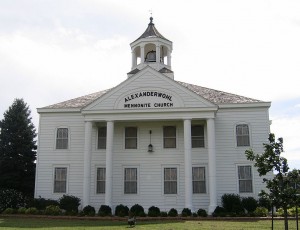
Image: Jon Harder
So now that you’ve started the site, do you have a sense of the scale of the problem?
I would say that the problem exists in the Mennonite Church just as it exists in the United States. I don’t think that sexualized violence is necessarily more prevalent with Mennonites than it is at any college, university, or city in the U.S. I think that rape culture exists everywhere. But I would say because sex is typically a taboo subject in Christian circles, and seems to be in Mennonite circles, that the topic of rape and sexualized violence is a whole less likely to be brought up then it would be in a secular setting. For example, at my Mennonite college we never had any sort of rape advocacy training during orientation. Yet I know at the University of Iowa they have mandatory programs for students to go to, in addition to student tours to the Women’s Resource and Action Center and their on campus center for rape and sexual violence. So, therefore, I do think that though the actual act of rape is not necessarily more prevalent, it will be more challenging to bring about some change, and as silence around these topics remain… so does the abuse itself.
You mention schools and colleges. Does your work also look at sexual abuse within other Mennonite institutions — in particular, the churches themselves?
Yes, I’m looking at the Mennonite Church USA as a whole, so within schools, institutions, and the churches themselves. I’m also focusing on sexual violence in general – not necessarily church leaders, though that does happen (and cases have been recorded and reported). But I don’t want the stories to be focused so much on who the abusers are, as much as the general fact that abusers come in all forms – family members, teachers, lawyers, neighbors, doctors, friends, pastors, counselors, and so forth. The main goal is to point out that if the church continues to remain silent about rape stories, because it’s an uncomfortable and yucky topic and it’s just easier to not address it, then these stories are going to continue happening to our loved ones. Also important to point out that these stories probably have happened to our loved ones, and we don’t even know.
You say that speaking about sex is a taboo in Christian and Mennonite circles — and hence, sexualized violence is less likely to be brought up. Can you tease that idea out a little bit more? After all, one would think that any act of violence would get the attention of a Christian community — even if it’s connected to a taboo.
Well, I would say this is more focused around the purity myth – the idea that women are supposed to remain chaste and pure, and that it’s additionally their responsibility to keep men chaste and pure. Rape stories in the Bible promote this idea, and most Christian circles believe this in some way or another. One man told me that he was talking to a group of Mennonite men, and he mentioned that I was going to be speaking about these issues at a church. One man responded, “Well why do we need to talk about it? It’s women’s faults they get raped because they dress provocatively.” I do not think this man is a bad man, I just think that he’s been inundated with rape culture and purity myths since he was a boy, and it’s hard to uproot those kind of naïve thought processes. Unfortunately, many people – both in the church and not in the church – equate rape with sex. The truth is that rape is not sex, it’s violence. “Sex” is the weapon of choice to carry out a violent act, but again I even hesitate to call it sex, because rape is not sex. I think the church has to start talking about positive sexuality in addition to rape prevention materials. We need both in order to healthily understand the issue, and fix it.
Before we discuss fixing the issue, maybe you can help us understand how these institutions are broken. You say that they have responded poorly to sexual abuse reports. Can you give examples?
A good example would be story #3 on the Our Stories Untold blog. The author went to her Mennonite college’s administration about her rape, and in the end was belitted and essentially told to get over it, that the young men who did it to her were good boys, and since she was promiscuous she was somehow asking for it. When this woman sent in her story I was shocked at how strikingly similar it was to one of my own college friend’s stories. The only difference was that this woman’s story was from the 1980s, whereas my friend’s story was from the late 2000’s. This definitely shows how institutions are broken. How can these places still be handling situations as bad as they did in the 80s? The fortunate thing is that from my own friend’s experience, though the damage done to her was irreversible, the school did acknowledge their horrible handling of the case and have since restructured their sexual assault policies and action plans. Additionally, I know the church has worked on a large scale to restructure policies. They’ve also had in-depth discussions about pastoral abuse, and I have confidence these conversations will only continue to happen. I just want them to happen sooner than later, and will do my part to promote that.
What do you think has prompted the large-scale restructuring?
Well, in that specific case at my school I think there was a definite acknowledgement of woah, we handled that really badly and hurt people in the process. Let’s never let that happen again. I think being able to step back and admit fault in the situation was, and is, so important in all institutions restructuring their sexual violence policies and procedure. There has to be an accountability and a confession of wrongdoing in order to create change. Fortunately, I see the church starting to own up to their mistakes or mishandling of cases, and through that reflection they’re able to create more restorative ways to handling these cases.

There is, however, a difference between talking about a problem, even putting policies in place, and actually solving it. The Roman Catholic Church has been talking a lot about clergy sexual abuse for three decades, and dioceses have implemented wide-ranging prevention procedures… but still, it doesn’t seem to stop happening.
Yes, I agree, there’s definitely a difference between talking about a problem and then actually solving it. I would say that the Mennonite church is more receptive to actually solving this issue than perhaps the Roman Catholic church is. Since the Mennonite church is a peace church, they really do aim to promote peace in all settings. They recognize that this is an issue they need to deal with, just like they recognize that Syria is an issue that they can assist in or that immigration is an important issue to pay attention to. I definitely do not think the Mennonite Church has “solved” this problem, but I do think they’re taking necessary steps towards that. Will this problem ever be solved? It’s hard not to think that rape will always exist. But we can at least get to a point that a woman (or man’s) story is never doubted, and where the church jumps up to assist in a situation and work towards healing, rather than shrink from the problem and leave the victim abandoned.
One particular characteristic of the Mennonite church is that it has a relatively non-hierarchical form of governance… there’s no Mennonite pope, so-to-speak. Does having various jurisdictions which are at about an equal level make it harder or easier to implement prevention procedures? I’m wondering if responsibility doesn’t get sort of shifted from one official to another (school to church to different church, etc.)
Also I think a lot of Roman Catholics would say their church is also a peace church… you might just want to make a clearer distinction there.
That’s true about the Roman Catholic church being a peace church. I think part of the difference is what you said, the non-hierarchical structure. I also think the fact that the Roman Catholic Church is huge, whereas the Mennonite church is tiny, makes a difference in how these issues are talked about versus actually handled. I do think the Mennonite church can be drug back by i’s non-hierarchical form of governance, in the sense that Mennonites generally want a consensus on an issue, and so discussions can go in circles and an issue can remain in limbo land if not everyone is in agreement. Even so, I think Mennonites are able to pass through issues faster than a larger church, such as the Roman Catholic church, can because of the fact that they’re much smaller. There are power imbalances in all institutions, but from my observations it does seem like the Mennonite Church attempts to address those power imbalances – for example, they’re not comfortable with one person being “in charge” or having the final say on an issue. They’re also increasingly becoming much more attuned to inclusion of minority groups within the church and with being very intentional to give everyone a voice at the head table. Still, there’s issues, as there are everywhere.
Back on the peace church thing, pacifism is a historically important aspect of the Mennonite Church. Many Mennonites were killed in Europe for their beliefs in not participating in a political structure or obeying their kings. Therefore, I do think that sets is apart from the Roman Catholic church as a “peace church”.
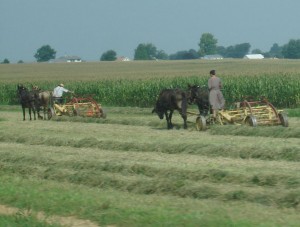
Image: Stilfehier
Your personal tradition is general Mennonite — a group which is relatively integrated into American society. But some Mennonite groups, like the Old Order Amish, are more closed — that is, the general public doesn’t get information about what’s happening inside these communities, especially in matters of sexual violence. Have you found any stories of such violence and the response to it within the more enclosed branches of Anabaptist/Mennonite groups?
The day I published my site I got a public comment on the “About” page that said, “A friend guided me to this site, and I will be thanking her… this is truly an important project! While I did not grow up Mennonite, I did grow up Amish and dealt with incest. In fact, I wrote about it in my memoir Why I Left the Amish. I will be following this project and I wish you great success in gathering stories. Abuse can only exist when shrouded by silence. Let’s break that silence with a chorus of voices!” Also, one Mennonite woman wrote about her own mother’s upbringing as Amish and how her father abused her, and actually spent time in prison for the rape. I wrote about that here. I got similar stories or statements such as this sent to me via email, and I know that incest is a pretty prevalent problem in Amish communities based off of other books. I think because of the fact that the Amish are so closed off from society means that it’s easier for these issues to happen and to go unreported. Again though, I’m really not a scholar of Amish or conservative Mennonite traditions so other then stories sent to me, I don’t feel like I can offer much expert knowledge.
That’s already a lot — that you’re getting emails from Amish (or perhaps, former Amish).
Yeah, definitely former Amish. I don’t think Amish do email. [laughs]
What is it like, personally for you, to encounter these stories so frequently? What has your emotional reaction been? Has it changed over time?
At first it was very overwhelming. I definitely got the most emails sent to me when I first released the project back in June. For some reason I hadn’t prepared myself for the emotional toll the stories would take on me. I felt so honored that people wanted to share their story with me, but I also felt like just posting their story on the site (or not, as most requests were) wasn’t necessarily enough; I wanted to be able to do more, yet really couldn’t. Over time though I realized that it was just important for these storytellers to have someone who was so open and receptive to their story – that’s really all they wanted and needed. It wasn’t about sharing them with me as much as it was being able to share them with a person who cared enough to receive them.
I definitely still have strong reactions to stories – each story is so universal, yet so individual, and I cry every time. Yet, I also see it as a healing passage. It’s also overwhelmingly beautiful when someone comes back 6 months after first sharing their story, telling me they are ready now to post it. That’s just amazing to me. Many of these women came forward with their stories before I even did. I understood the tremendous courage it took to do what they did by giving me the ok to post the story.
How are you going to harvest more stories, and what are your future plans?
Well, harvesting stories is definitely a challenge. I’m hoping to go on a speaking tour to Mennonite churches, which will most likely promote the project more and encourage people to share their stories. I also hope to start healing workshops with another woman who wants to partner with me on Our Stories Untold. Healing workshops would work on the process of telling the story. Of course though, it’s up to the story teller to decide when it’s time to tell their stories. I understand that it’s a really hard thing to do, and I don’t want to push anyone to do it if they don’t want to. When people express even the smallest interest in sharing though, I highly encourage them to do it as I really do think it’s important for these stories to be known and acknowledged. I’ve also sent follow-up emails to people who emailed me their story and expressed an interest in future site sharing.
Ultimately, I just see this work as a vital proponent to change, and I’m encouraged to see so many people interested about the project. I feel there is a shift happening in the church and the world on issues of sexualized violence, and I’m more than happy to help that shift occur by opening up a space like Our Stories Untold.
How much can we say that this shift was made possible by the Internet?
I definitely think it’s a huge component! Obviously knowledge is needed to bring about any change, and now that knowledge is so accessible, it’s much easier to bring about consciousness than it was, say, 20 years ago. How would these stories have been gathered and shared before the time of the Internet? I’m sure it could have been done, but it would have been much harder.

